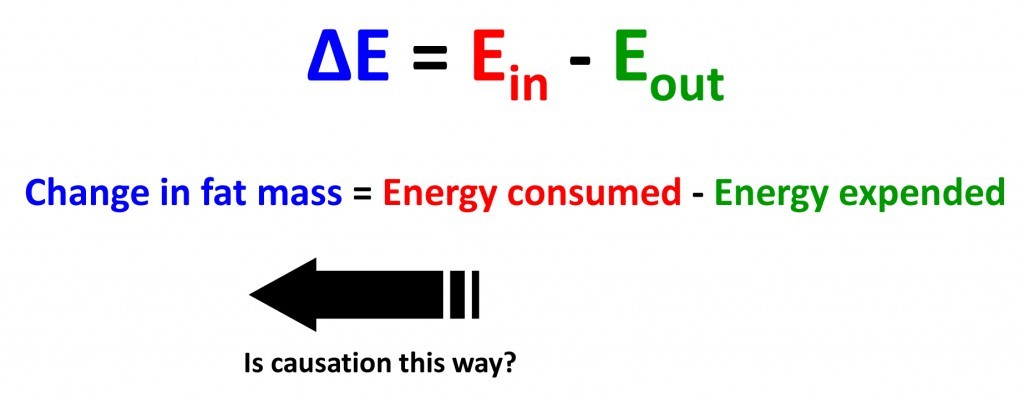I’ve written about obesity (i.e., unregulated horizontal growth) being caused by excess insulin, which in turn leads to overeating and under-moving. This is contrasted with the reverse – overeating causing obesity. Let’s double-click on this idea using one of the most important laws governing our universe – the First Law of Thermodynamics.
Whenever people like me or Gary Taubes or Rob Lustig say, “Calories-in-less-calories-out does not explain obesity,” we’re bombarded by folks screaming, “Hey – you’re violating the First Law of Thermodynamics…,” so let me address this point head on.
Below is the First Law in its simplest form. It states that energy cannot be created or destroyed – that is, the change in energy of a system (blue term) is equal to the energy entering the system (red term) less the energy exiting the system (green term). To make this specific to our question, let me state it this way: the change in fat mass of a person is equal to the difference between the energy consumed and the energy expended.

No one disagrees with this point (except maybe folks who think the world is flat or that the sun rotates around the earth). Here is where the trouble starts…
Most obesity “experts” assume (erroneously) that the big equal sign between the blue and red terms implies a direction of causality. In other words, they assume that an increase in fat mass (the blue side gets bigger), was CAUSED by the red number being bigger than the green number.

So is this the case? Was the increase in fat mass CAUSED by more energy entering the system than leaving the system (i.e., was the gain of fat CAUSED by eating more calories than expending)? If obesity is caused by overeating, the causation arrow points from right to left, as in the figure below.

Or is it the reverse? Was the positive energy balance (more energy entering the system than leaving the system) the RESULT of a change in fat mass? In other words, does the drive to become obese (i.e., the drive to accumulate fat rather than oxidize it) cause over-eating? If this is the case, the causation arrow points from left to right, as in the figure below.

Obviously, I believe the latter over the former, but the point is that neither argument commits the cardinal sin of “violating the First Law of Thermodynamics” as so many people assert when one suggests the “calories-in-less-calories-out-determines-change-in-fat-mass” model is incorrect.
To reiterate, I am not for a moment suggesting that energy balance or thermodynamics are being violated. I’m saying they do not tell you WHY our bodies choose to accumulate fat instead of burn it. A growing child, for example, is consuming more energy than he is expending (which allows him to grow), but this is not the CAUSE of his growth, it’s the RESULT of his growth. A pregnant woman isn’t gaining fat during the pregnancy BECAUSE she is eating more energy than she’s expending. She’s creating a positive energy balance BECAUSE her hormones are driving her to create this energy balance so she can support the fetus.
Let me use one more example I’ll borrow from Gary Taubes to illustrate this subtle distinction. Look at the picture, below, of the crowded room. Let’s explain what’s going on this room in terms of thermodynamics. The First Law would say something like this: The change in the number of people in the room must be equal to the difference between the number of people entering the room and the number of people leaving the room. For example, if the room “gains” 10 people, we can safely conclude that 10 more people entered the room than left it (e.g,. 15 versus 5, or 197 versus 187).

So here’s the million dollar question: Why is the room packed? Let me be more specific, why are there 78 people in the room? The “calories-in-minus-calories-out-model” says, “because 78 more people entered the room than left the room.” I say, sure, that’s true, but it doesn’t tell me WHY? I want to know WHY there are 78 people in the room (or, more specifically, WHY did 78 more people enter the room than leave the room)? Was it because there was a very compelling speaker in the room? Was it because they were giving away free food in room? Was it because it was raining outside and folks wanted to stay dry?
If my goal is to keep people out of the proverbial room, I’d better understand what brought them into the room. I need to know what is causing the room to accumulate people. Restating the First Law offers me nothing beyond the obvious. Of course more people entered the room than exited the room. How does that help me get people out?
Similarly, when someone tells me so-and-so is obese because he eats more than he expends, I say, “of course he does…you’re just re-stating the First Law.” What I want to know is, WHY did he eat more calories than he burned? If we don’t understand this point, how can we treat this condition?



